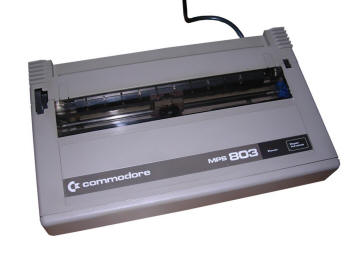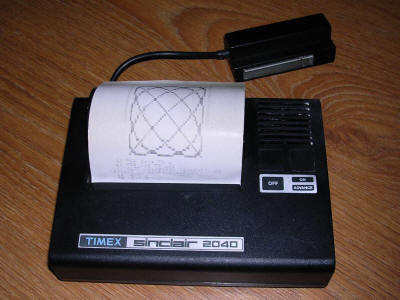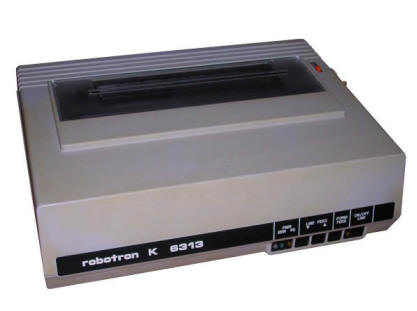Printers
Printers for 8-bit microcomputers were usually dot matrix printers or thermal transfer printers. While dot matrix printers were expensive and used any type of paper with quite good typewriter-like quality, thermal transfer ones had to be used with special alluminium based paper, in which the printout was applied using thermal head. Printout was not permanent, as it just vanised after few years because of oxidization and chemical de-activation of alloy powder used.
| MPS-803 |
|
||||
| Manufactured by: Commodore | |||||
| Type: Dot matrix printer | |||||
| Interface: Commodore 64/128 serial port | |||||
| Paper format: A4/letter | |||||
|
Information: An original printer for Commodore 64 and 128 computers, was indentified in system as serial logical device (usually No. 4), allowing to print from BASIC or programs. |
|||||
| To print a program, make sure that you have a good ribbon in printer and it's placed properly to the gap in printing head and buffer on the right. Next, select device number with appropriate switch (left one, select 4 or 5), you can also select Lines per Inch (LPI, right switch, 6 or 8). | |||||
| You can connect MPS803
to serial floppy disk drive or directly to the computer. To print something useful on your MPS803, you should open a BASIC file which redirects to serial port and then direct everything you want to print to this file. For example: OPEN1,4 PRINT#1THIS LINE WILL BE PRINTED" CLOSE1 To print something more, you can redirect all screen output to the printer. In this example, we will print a BASIC program listing. Load or write some BASIC program and type: OPEN1,4 CMD4 LIST PRINT# CLOSE1 Here we did: 1. Opened file which points towards serial port device "4". 2. Directed screen to port "4". 3. Listed program (nothing will be displayed on screen!). 5. Flushed buffer by telling printer to pring nothing. 6. Closed file. |
|||||
| Timex Sinclair TS2040 |
|
||||
| Manufactured by: Timex-Sinclair | |||||
| Type: Spark printer | |||||
| Interface: ZX81/TS1000 system bus | |||||
| Paper format: 10cm roll Al-coated paper | |||||
|
Information: Printer for Timex Sinclair 1000 computer, it was connected to system bus by pass-through adapter. The printer can print only in a special Alluminium-coated paper. Below Al coating the paper is black. During printing, a needle-like head is connected to high voltage source and Al layer is connected to the second pole. The spark fires and melts/evaporates a small amount of coating making black dot. This is not a high-quality printing, but it's sufficient. |
|||||
| The most
simple printing test is a typical "print screen" test. After
filling screen, issue COPY command. It should print contents of
screen. To print, printer must be powered on and not turned off
by switch. Times 2040 was in fact a modified ZX Printer, with external power supply. Original ZX printer was powered by ZX81 itself, it caused some problems with power consumption. |
|||||
|
|
|||||
|
Manual (for ZX Printer) on World of Spectrum site. This printer needs 24V AC at 1.2A to work, it is supplied by typical power jack:
Test program: 10 FOR I=-4 TO 4 Then after few minutes of drawing circles, use COPY command with printer turned on. |
|||||
| Robotron K6313 |
|
||||
| Manufactured by: Robotron | |||||
| Type: Dot matrix printer | |||||
| Interface: RS232 port (other interfaces possible) | |||||
| Paper format: A4 or continuous A4. | |||||
|
Information: 9-pin dot matrix printer manufactured by Robotron industries since 1980s. It can be connected to different interfaces by using exchangeable interface cartridges: RS232, IFSS, Centronics or even Commodore serial port. Font ROM is stored in replaceable cartridge inside printer. K6313 prints in text mode offering different code pages selectable, as well as interface properties, by DIP switches. In some versions it orints graphics using Epson FX80 codes. |
|||||
| The printer in most versions can print using reel-type typewriter ink tape. | |||||
|
|
|||||
|
After filling a reel, tape returns automatically.
However, I don't recomment using carbon-type typewriter tapes in
this printer. They pollute metal types of some smaller
typewriters and will definitely clog the head. This is a typical German technology these times - using rather robust technology, but it's rock solid. My unit has been extensively used and there is no wear on linear bearing at all. Printing head has large, powerful electromagnets visible from outside. This printer was shipped with a wide range of computers. From PC1715, late A5120, KC85, PCs like CM1910/A7150, A7100 or EC1834 to measurement systems.
|
|||||







